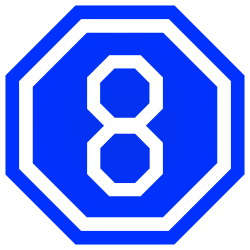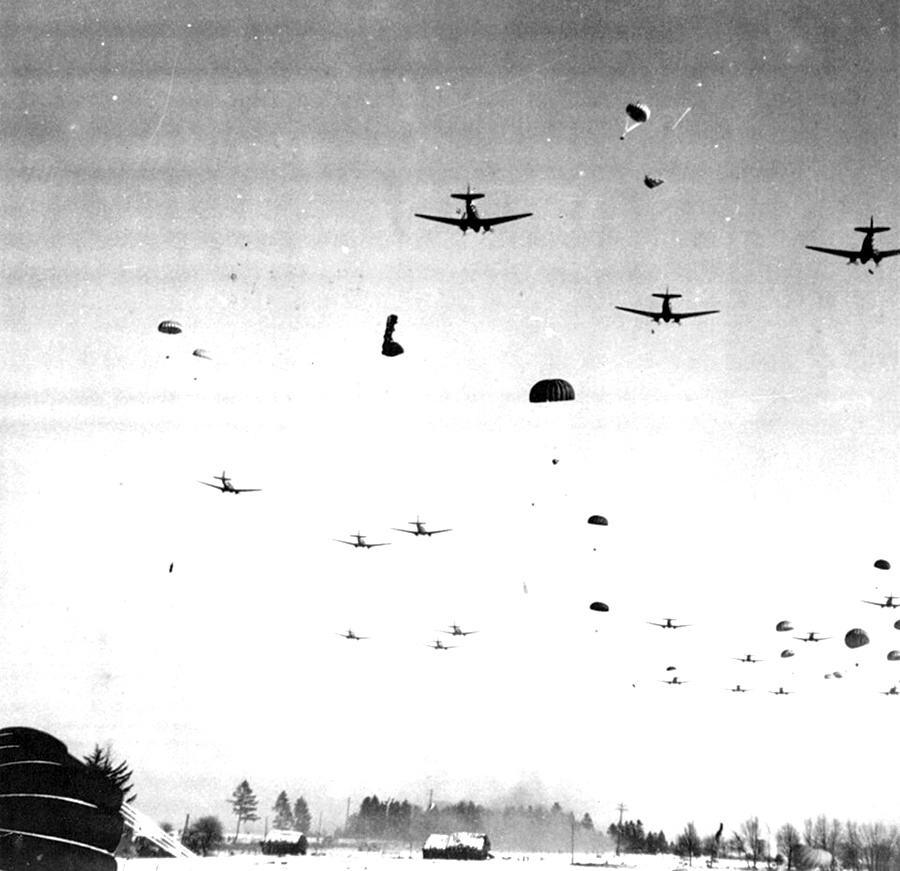Von Rundstedt realized by December 24, that it was impossible to reach the Meuse River. Since the attack had no anchor point in the west, the situation in that area was fluid. The German High Command advised withdrawing in order to conserve their slender resources for future defense of the Rhine River. Hitler refused to admit the defeat and ordered a concentrated attaok on Bastogne. Three Volks Grenadier Divisions were added to Branderberger 7.Army to help stop the advancing of Patton’s 3-A. The 1.SS-PD (LSSAH), the 9.SS-PD (Hohenstaufen), the 12.SS-PD (Hitlerjugend) and the remaining men of the Führer Begleit Brigade were ordered south to Bastogne. Three other divisions from the 47.Panzer-Corps, the 2.PD, the Panzer-Lehr and the 26.VGD had attacked Bastogne on December 20 after overrunning the Combat Command of the US 9-AD at Longvilly one day before. By this time, the 101-A/B had had time to organize the defenses. With orders only to occupy the town if not strongly held, the Germans had hoped for a quick success.
Failing to take it on December 20, the two panzer divisions bypassed Bastogne on the west and headed for the Meuse River. One Panzer Regiment was left behind to assist the infantry in the capture of the town. On December 21, a ring had been formed encircling the defenders and the assaults continued. The resupply of the US troops was done by air on December 23. Though the fighting was severe the Germans made, no substantial gains. Hitler now ordered the 15.PGD – with elements of the 660.VGD to reinforce the assaulting units. Two additional Volks Grenadier Divisions were added to the German 7.Army to assist in holding off Patton’s 3-A. The US III Corps (US 3-A) on December 22, advanced to a line generally east and west with Martelange in the center. The US XII Corps joined the III Corps on the right, its line extending to Echternach and then bending south along the Sauer and the Moselle. Air support was provided by the XIV Tactical Air Command (TAC).
(Photos Above) The IX Troop Carrier Command, USAAF, played an important role during the siege of Bastogne by dropping supplies for the encircled ground troops.
 The advance continued against increasingly stubborn resistance and by December 25, the 4-AD was within five miles of Bastogne. On December 26, it succeeded in forcing a narrow corridor into the town. Though the Germans battled to cut the corridor the defenders of Bastogne could now be reinforced and supplied. The heaviest fighting for Bastogne was now to begin. Otto Remer’s Führer Begleit Brigade, on December 28, made a desperate attack to cut the corridor. This attack failed. By the first of the year the reinforcements from Dietrich’s 6.PA had joined the assaulting forces around the city. A total of eight divisions were now arrayed around the town, attempting to reduce the salient that extended into their lines of communication.
The advance continued against increasingly stubborn resistance and by December 25, the 4-AD was within five miles of Bastogne. On December 26, it succeeded in forcing a narrow corridor into the town. Though the Germans battled to cut the corridor the defenders of Bastogne could now be reinforced and supplied. The heaviest fighting for Bastogne was now to begin. Otto Remer’s Führer Begleit Brigade, on December 28, made a desperate attack to cut the corridor. This attack failed. By the first of the year the reinforcements from Dietrich’s 6.PA had joined the assaulting forces around the city. A total of eight divisions were now arrayed around the town, attempting to reduce the salient that extended into their lines of communication.

 On the west, in the VIII Corps zone, the 11-AD joined by the 17-A/B and 87-ID attacked northeastward in the general direotion of Houffalize. Gen Eisenhower feeling that the Meuse River was no longer in danger of being forced had personally ordered the attaok. The German penetration had reached its deepest point on December 24 when the elements of the 2.PD had reached
On the west, in the VIII Corps zone, the 11-AD joined by the 17-A/B and 87-ID attacked northeastward in the general direotion of Houffalize. Gen Eisenhower feeling that the Meuse River was no longer in danger of being forced had personally ordered the attaok. The German penetration had reached its deepest point on December 24 when the elements of the 2.PD had reached 
 Celles. Though heavy attacks caused the Allied lines to refuse in some areas the general trend was toward the reduction of the German salient. The Allied lines now formed a solid wall around the penetration. German pressure had eased on the north flank as the US 1-A planned its counterattack to open on January 3, 1945.
Celles. Though heavy attacks caused the Allied lines to refuse in some areas the general trend was toward the reduction of the German salient. The Allied lines now formed a solid wall around the penetration. German pressure had eased on the north flank as the US 1-A planned its counterattack to open on January 3, 1945.
German forward elements, forced by the threats to their flank, withdrew to the east on a general line Marche, Rochefort, and St Hubert. The British XXX Corps closed the gap existing between the US 1-A and the US 3-A from Rochefort south to the vicinity of Neufohateau. The German counterattack is beyond the scope of this monograph. But much hard fighting was necessary before the Germans were again driven back to the shelter of the West Wall. The effects of the offensive are still a much-debated question. Some authorities believe it shortened the war by several months since the German reserves dissipated in the attack weakened the defense of the Rhineland and hastened the end. Others believe that it lengthened the war by causing the Allies to regroup to meet the attack and then to redispose to continue the offensive.
ANALYSIS & CRITICISM
In analysing and criticising this offensive action, we find that the Germans, attaining complete surprise, breached the Allied lines over a width of 60 miles and penetrated Allied territory to a similar depth. A series of errors and miscalculations resulted in the weakness of the Ardennes Area into which the Germans attacked. Allied intelligence officers first over estimated the effect of the German defeat in the preceeding summer in France. They compounded that error by under estimating the German ability to recover and failed to recognise indications of recovery which were plainly evident. They further failed in properly evaluating and interpreting evidence of the troop movements prior to the offensive which indicated an offensive buildup in the area opposite the Ardennes.
Gefreiter Hitler had become a corporal in the German Army after four years in the trenches of World War One. He was not a trained professional soldier yet as head of a totalitarian state he could and did command the German Army. Being untrained, his thinking and planning were unorthodox, a fact to which is owed much of the early German successes. This fact was not recognized by the Allied High Command when it was decided to maintain a defense which was little more than a screening force in the Ardennes Sector. It is significant that FM von Rundstedt and FM Mödel, both well-trained professional soldiers, objected to the Ardennes attack on the grounds that it was beyond the strength of the available forces. They recommended that the attack be made in the Aachen area in an attempt to eliminate the Allied salient there which contained a heavy troop concentration. This is the area where the Allied Intelligence believed an attack would be made if the Germans did assume the offensive.
The elaborate and drastic means taken by the Germans to insure the surprise was far more successful than they had hoped and were largely responsible for the initial success. However, had the Allied Intelligence been functioning properly it need not have been so effective. The months of November and December are notorious for poor flying weather in Europe, and the year 1944 was no exception. This rendered impossible the reconnaissance flights necessary to observe and verify reports from other intelligence sources. The defense maintained by the US VIII Corps in the Ardennes sector was scarcely more than a screening force. Distance between, strongpoints precluded mutual support, coordinated fire plans, and anti-tank defenses. Depth was lacking. The reserves, though mobile were inadequate for the 80-mile sector, therefore it can be said that mobility was lacking. Security was insufficient to guard against surprise. Had patrolling been actively carried on during the period of December 14-15, the German preparations immediately prior to the attack would have been discovered.
It was not until armor was brought into action against the advancing Germans that the attack began to lose its momentum. Armor must be utilized in the defense to provide mobility and striking power necessary to combat armor in the offensive. The Germans committed more troops to the offense in the narrow the gap between the St Vith salient and the north flank, than the available roads would accommodate. The resulting jammed highways seriously hampered the attack until after the fall of St Vith and much valuable time was lost. The lack of reserves was a handicap to the Allied High Command. With only two divisions available in the Theatre reserve SHAEF was hard-pressed to meet the assault. The lack of Allied Tactical Air support in the early days of the offensive reacted favorably to the Germans. Had the weather permitted continued air attacks on the heavily armored concentration in the north corridor on December 18-19, the results may well have forced the Germans to abandon the attack.
German weather forecasts had predicted the weather conditions which existed prior to and during the early days of the attack. It proved a valuable ally. While the Germans had created a wide gap In the Allied lines, the stand at St Vith and at Bastogne had the effect of narrowing the gap since they limited the available road space in the penetrated area. The available roads would not support a thrust to the Meuse River. While the German commanders realized this, Hitler did not and ordered the attack continued long after its failure was certain.
LESSONS
Lessons to be gained from a study of this offensive action are listed below.
1. In the calculation of risks consideration should be given to the unorthodox character of the thinking of the enemy high command.
2. It is the function of intelligence to evaluate and interpret, information and apply it to the tactical situation in terms of capabilities.
3. Surprise is an essential element in a successful attack. Adequate security measures must be undertaken to assure surprise.
4. Defense should be organized in depth.
5. Mutual support must be provided between strong points in defense.
6. A coordinated fire plan is necessary for a properly constructed defense.
7. Coordinated anti-tank defense plans must be formulated.
8. Mobility must be provided by adequate reserves.
9. Security sufficient to guard against surprise must be maintained.
10. Adequate reserves must be maintained by all echelons of command from the platoon to Theatre.
11. Air reconnaissance is necessary for modern warfare.
12. Taotioal air support is valuable in defense as well as offense,
13. Armor must be included in the defense to provide the mobility and striking power necessary to combat armor which will be invariably committed in the offense.
14. The number of troops which can be committed in an offensive action is limited by the available road and maneuver space.
15. The width of the base limits the depth of the penetration.
Additional Researches & Info
https://chindits.files.wordpress.com/2019/11/the-battle-of-the-bulge-16-19-dec-44.jpg
https://www.tracesofwar.com/articles/4268/Mine-sweeping-activities-on-the-Scheldt-1944.htm
https://www.bergflak.com/pstrain.html
https://en.wikipedia.org/wiki/Schnee_Eifel
























